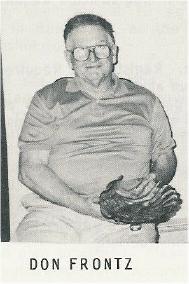National Cambridge Collectors, Inc.
A non-profit 501(c)(3) organization.

Worker of the Month - Don Frontz
by Lorraine Weinman - Issue #205 May 1990
At the March meeting, Don Frontz and his wife Betty, were guests of the Cambridge Cordials Study Group. Don Frontz provided us with a wonderfully informative presentation in our continuing project to interview former Cambridge Glass Company workers.
 Don worked at the Cambridge Glass
Factory in the Hot Metal Department from 1940 until 1951. He came
prepared with some interesting pictures and personal stories to
share with us. Several of these pictures will be displayed at the
Museum.
Don worked at the Cambridge Glass
Factory in the Hot Metal Department from 1940 until 1951. He came
prepared with some interesting pictures and personal stories to
share with us. Several of these pictures will be displayed at the
Museum.
Don vividly described the process of getting a job at the glass factory, as he did at the age of 16. He identified the difference between the two unions that were in existence: Local 74 - the "skilled" workers; and Local 504 - the "boys" workers. It was interesting to learn that he, like others, had to "stand in line" at the factory to wait until he was needed to fill in someplace. He stated that this was like trying-out, because if they liked the work that you did in a job, they would probably have you back at that position again. He described the process of going through the channels to become a presser or finisher: how one could start out by "warming-in" or "carrying-over" and was not allowed to touch a punty or press until they had been there for about a year. After a year, in order to become an apprentice, one would have to be represented by a member of Local 74.
Since he was experienced as a "gatherer," Don was able to present a realistic picture of this position to the group. The quality of the glass piece depended a lot on the gatherer and presser working well together. The gatherer had to gauge how much glass to bring out on the punty and to put it into the mold correctly for the presser, so that he could cut it off without leaving shear marks or lap marks. This teamwork was an important factor.
Don detailed the entire process: from the furnace and the pots to the finished glass pieces. He made the work come alive through his accounts and amusing personal stories. It was easy to see that it was extremely hard work, but that humor was often interjected. How fascinating it was to hear the "move" figures (the amount of an item that the shops were to produce in four hours) that he quoted. It's amazing to think of their producing 600-700 small items (like salts) or 260-300 larger items (like nudes) in that amount of time. And to think that they sometimes produced even more than their "move!"
Don has provided us with an excellent videotape. The information and experience which he has related are well worth hearing. His accounts are complete and easy to understand. We appreciate that he has been willing to share his knowledge with the Cambridge Cordials and with other N.C.C. members.